Solution Of Capacitated Vehicle Routing Problem For A Food Delivery Company With Heuristic Methods
Araç rotalama problemi, Kapasiteli Araç Rotalama Problemi, En Yakın Komşu Algoritması, Fisher ve Jaikumar algoritması, Clarke ve Wright’ın tasarruf algoritması
Solution Of Capacitated Vehicle Routing Problem For A Food Delivery Company With Heuristic Methods
Vehicle routing problem, Capacitated Vehicle Routing Problem, Fisher and Jaikumar algorithm, Clarke and Wright’s savings algorithm, Nearest neighbor algorithm,
___
- Baldacci, R., Mingozzi, A. & Roberti, R. (2012). Recent exact algorithms for solving the vehicle routing problem under capacity and time window constraints. European Journal of Operational Research, 218(1): 1-6.
- Bozyer, Z., Alkan, A. & Fığlalı, A. (2014). Kapasite kısıtlı araç rotalama probleminin çözümü için önce grupla sonra rotala merkezli sezgisel algoritma önerisi. Bilişim Teknolojileri Dergisi, 7(2): 29-37.
- Caccetta, L., Alameen, M. & Abdul-Niby, M. (2013). An improved Clarke and Wright algorithm to solve the capacitated vehicle routing problem. Engineering, Technology & Applied Science Research, 3(2): 413-415.
- Christofides, N. (1976). The vehicle routing problem. Revue française d'automatique, informatique, recherche opérationnelle. Recherche opérationnelle, 10(V1): 55-70.
- Clarke, G. & Wright, J.W. (1964). Scheduling of vehicles from a central depot to a number of delivery points. Operations Research, 12(4): 568-581.
- Cordeau, J.F., Gendreau, M., Laporte, G., Potvin, J.Y. & Semet, F. (2002). A guide to vehicle routing heuristic. Journal of the Operational Research Society, 53(5): 512-522.
- Dantzig, G.B. & Ramser, J.H. (1959). The truck dispatching problem. Management Science, 6(1): 80-91.
- Fisher, M.L. & Jaikumar, R. (1981). A generalized assignment heuristic for vehicle routing. Networks, 11(2): 109–124.
- Hashi, E. K., Hasan, M. R., & Zaman, M.S.U. (2015, November). A heuristic solution of the Vehicle Routing Problem to optimize the office bus routing and scheduling using Clarke & Wright's savings algorithm. In 2015 international conference on computer and information engineering (ICCIE) IEEE, 13-16.
- Keskintürk, T., Topuk, N. & Özyeşil, O. (2015). Araç rotalama problemleri ile çözüm yöntemlerinin sınıflandırılması ve bir uygulama. İşletme Bilimi Dergisi, 3(2): 77-107.
- Kosif, B. & Ekmekçi, İ. (2012). Araç rotalama sistemleri ve tasarruf algoritması uygulaması, İstanbul Ticaret Üniversitesi Fen Bilimleri Dergisi, 11(21): 41-51.
- Laporte, G., Gendreau, M., Potvin, J.Y. and Semet, F. (2000). Classical and modern heuristics for the vehicle routing problem. International Transactions in Operation Research, 7(4-5): 285-300.
- Lysgaard, J. (1997). Clarke & Wright’s savings algorithm. Department of Management Science and Logistics, The Aarhus School of Business, 44: 1–7.
- Solomon, M.M. (1987). Algorithms for the vehicle routing and scheduling problems with time window constraints. Operations Research, 35(2): 254–265.
- Sultana, T., Akhand, M. A. H., & Rahman, M. H. (2017, May). A variant Fisher and Jaikuamr algorithm to solve capacitated vehicle routing problem. In 2017 8th International Conference on Information Technology (ICIT) IEEE, 710-716.
- Toth, P. & Vigo, D. (2002). Models, relaxations and exact approaches for the capacitated vehicle routing problem. Discrete Applied Mathematics, 123(1-3): 487-512.
- Ulutaş, A., Bayrakçıl, A.O. & Kutlu, M.B. (2017). Araç rotalama probleminin tasarruf algoritması ile çözümü: Sivas'ta bir ekmek fırını için uygulama. Cumhuriyet Üniversitesi İktisadi ve İdari Bilimler Dergisi, 18(1): 185-197.
- https://www.movable-type.co.uk/scripts/latlong.html, (07.09.2022).
- ISSN: 2148-3493
- Yayın Aralığı: Yıllık
- Başlangıç: 2013
- Yayıncı: Gökhan ÖZER
BORSA İSTANBUL’UN ASİMETRİK DİNAMİĞİNİN KANTİL OTOREGRESYON YAKLAŞIMI İLE İNCELENMESİ
Solution Of Capacitated Vehicle Routing Problem For A Food Delivery Company With Heuristic Methods
Pınar TAT, Abdullah ALTUN, Halit YANIKKAYA
DUYUSAL MARKALAMA YAKLAŞIMININ BİBLİYOMETRİK ANALİZ İLE İNCELENMESİ
